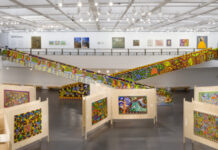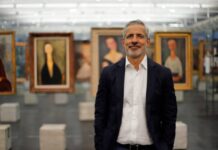Curator of 60th Venice Biennale, Adriano Pedrosa revealed this Tuesday (31) its plans for the exhibition, which will begin in April. With a total of 332 artists – compared to 213 in 2022 – the main international exhibition, titled Stranieri Ovunque – Foreigners everywhere, takes place in a world “full of crises related to the movement of people across borders”, according to Pedrosa.
For the curator, the title also expresses the “differences and disparities conditioned by [issues such as] race, sexuality and wealth”. He added that his own experiences are reflected in the theme, having lived abroad and identifying as “the first openly queer curator [of the Biennale].”
The list of selected artists reveals a significant presence of Brazilians, including indigenous people, naturalized foreigners, such as Claudia Andujar, and great names in modernism, such as Tarsila do Amaral. The participation of indigenous artists, highlighted Pedrosa, will be “emblematic”. The Mahku collective, from the border between Brazil and Peru, will paint a monumental mural on the facade of the Giardini Central Pavilion. At Arsenale, the Mataaho collective, from New Zealand, will showcase a large installation.

In general, the list of selected artists mixes emerging, mid-career or already established artists – including Beatriz Cortez, Simone Forti and Teresa Margolles – with a large number of well-known historical names, as well as recently deceased artists – such as María Izquierdo, Frida Kahlo, Wifredo Lam, Judith Lauand, Tomie Ohtake, Diego Rivera, Joaquin Torres-García and Rubem Valentim.
Similar to the 2022 edition, the exhibition will be divided into two parts: a Contemporary core, which highlights the participation of queer artists – such as Érica Rutherford, Isaac Chong Wai, Violeta Quispe, Louis Fratino and Dean Sameshima, as well as a room dedicated to “queer abstraction”, with works by the Chinese Evelyn Taocheng Wang – and a Historical core, for contemporary and historical work, respectively – a section with works by 1905th century artists from Latin America, Africa, the Arab world and Asia, dating from 1990 to XNUMX.
The current president of the Biennale, Roberto Cicutto – who will be replaced by Pietrangelo Buttafuoco, a right-wing journalist and author, appointed by the Italian Minister of Culture, and whose books include a biography of Silvio Berlusconi – highlighted the political dimension of the exhibition. According to him, the last edition would have been “prophetic, given the tragic events of the last four years”, such as the Russian invasion of Ukraine, the Hamas terrorist attack and the war imposed by Israel on the Gaza Strip. The Biennale is a “privileged point of view [from which to] curate the world”.
SEE TOO:
Curators Arissana Pataxó, Denilson Baniwa and Gustavo Caboco Wapichana talk about the Hãhãwpuá Pavilion, the Brazilian Pavilion at the 60th Venice Biennale













